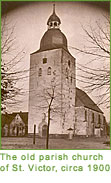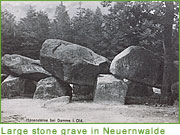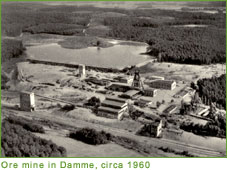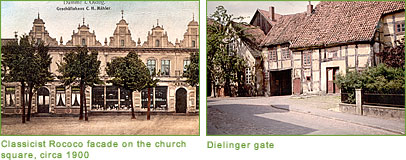|
|
|
|
 |
 |
|
|
|
|
|

 |
The beginnings of Damme´s history, which is thousands of years old, can be detected in its name and location. On three sides, Damme is bordered by fens, and to the north-west there is a belt of woodland on the slopes of the Damme Hills which acts as a sort of barrier. Hence, Damme has always been a favoured settlement area. Findings which date back to circa 4000 B.C., the turning point from the Early Stone Age to the Middle Stone Age, confirm this. Several large stone graves dating back to the Late Stone Age (c.2500 B.C.,) .e.g. in Neuenwalde, and burial areas belonging to the Bronze and Iron Age (c. 1700 B.C.,) in Bergfeine are evidence of continual cultivation and settlement in the Damme region. Later, the settlement became the centre of Saxon Dersa (also Dersi), which Charlemagne, respectively the Franks, captured and by which means the inhabitants were christianised and the first ecclesiastical foundation was established by the Bishop of Osnabrück. |
The Dersaburg, a rampart in the Damme Hills, lying between Damme and Holdorf, as well as the so-called "Römerschanzen" (Roman field fortifications) in Sierhausen, date back to this period. The latter consists of two small protruding ramparts which were built to guard the plank road across the fens on the south side. In 851, the first documented reference to Bokern is to be found in connection with the march bearing the relics of St. Alexander to Wildeshausen and as early as 872, Bergfeine was mentioned for the first time. |
 |
 |
Around this time, the "Meyerhöfe" were established. These were the farmsteads of the rural administrators who had special duties as administrative officers of the Franks, as well as special privileges, which the rest of the people did not enjoy.They were granted large estates and imposing farmsteads. In the present urban district of Damme, there were no less than eleven such farms.
Between 850 and 950, when the first church buildings were erected and a respective parish was founded, Damme was also assigned to carry out the administration in the parish. The oldest documented reference to the town dates back to 1180, even though Damme was the centre of Dersagau and a parish much earlier.
|
Later on, the conflict over the jurisdiction of the parish of Damme began between the Prince-bishops of Münster and Osnabrück and lasted for centuries. These differences were carried out at the cost of the Damme people, especially the farmers, and influenced their entire lives. Finally, in 1877, a solution was found when Damme became part of the duchy of Oldenburg (from 1829 onwards a grand duchy).
|
Since the Early Middle Ages, Damme has been a centre of business, commerce and trade, and of course an ecclesiastical and administrative centre which reached far into the surrounding district, and since the Second World War, it has been an industrial centre due to the Damme iron ore mine. The large size of the former parish, its administrative independence, from 1817-1879, the growth of the surrounding villages and its central location have all been significant factors.
For centuries, Damme and the surrounding villages have been characterised by their farming middle classes and still today intensive, arable and livestock farming play an important role in many of the outlying districts.
|
 |
The structure of the town first began to change during the time of the German Emperor when in the middle of the last century, industrialisation began. However, the impulse for industrial development in Damme was rather late and began first in 1939 with the opening of the ore mine which was later closed in 1967. Today, over 2500 people are employed in the metal, wood and plastic industry, in the production of agricultural machines, the construction of security systems and precision parts for the car industry, in long distant transportation and in industrial packing, as well as in the hospital which plays a significant role in the town of Damme. |
Damme has now 15,400 inhabitants and is the commercial centre of the surrounding region together making up a population of over 38,000. Due to the growing number of inhabitants, the structure of its location and its economical development, Damme was honoured with special distinction by the Minister of Lower Saxony on May 1st, 1982. |
 |
A significant sign of the ancient traditions of this region is the Damme Carnival, which has been celebrated in various forms since the Middle Ages, though rather uniquely, it is celebrated in Damme, a whole week earlier than anywhere else.
A detailed presentation of the history of Damme can be found in: Bade/Kessel/Oberpenning/Schindling (Hg.): Damme - Eine Stadt in ihrer Geschichte ( A Town in its History)
Thorbecke-Verlag, Sigmaringen 1993, 666 pages, numerous pictures.
|
Taken over with friendly permission of the city administration Damme (Mr. Kreye)
|
|
|
|
|
|
